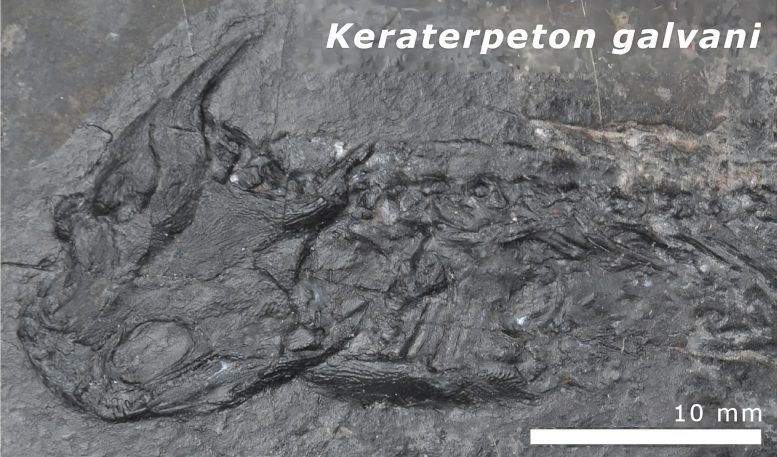
A photograph of the Jarrow amphibian Keraterpeton galvani. Credit: Dr. Aodhan O’Gogain, Trinity College Dublin
A mystery that has puzzled scientists for decades has been solved regarding ancient tetrapods, which were amphibian-like creatures that lived more than 300 million years ago.
The Jarrow Assemblage, an important fossil site in Ireland, contains fossils of these ancient tetrapods that appear to have had their bones cooked after death. These fossils were found in a coal seam in Co. Kilkenny.
Fossils from this site have one unique feature: their original internal bone morphology has been altered so that now it is difficult to make out detail from the fossils. The cause of this alteration has baffled scientists, with explanations for this alteration usually thought to be due to acid dissolving the bones when the animals were first buried. That is until now.
A team of scientists from Trinity College Dublin, University College Dublin, National University of Ireland, Galway, the University of Birmingham, and the Gemological Institute of America used a combination of computed tomography, to produce X-Ray images of the fossil, and laser ablation, to analyze the chemistry of the bones to investigate the causes of this alteration.
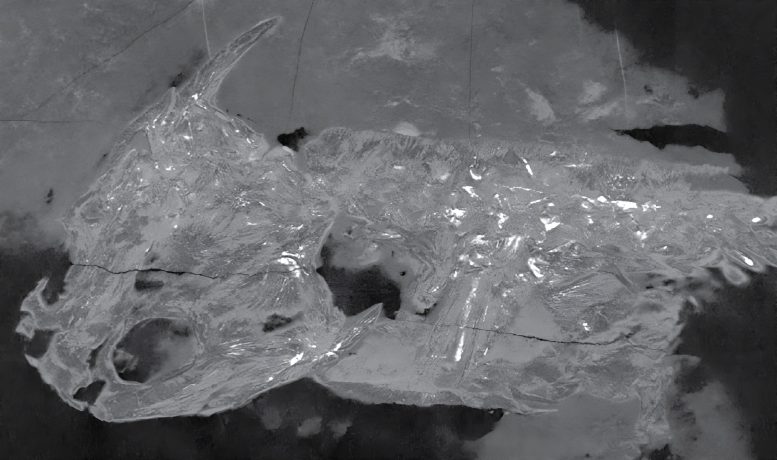
CT-image of K. galvani below showing the alteration in the bones. Credit: Dr. Aodhan O’Gogain, Trinity College Dublin
Dr. Aodhán Ó Gogáin, from Trinity’s School of Natural Sciences, is the lead author of the study. He said: “Normally in fossil bone, we see that the internal original structure is preserved. But when we looked at the X-Ray images of fossils from Jarrow we see that no internal bone morphology has been preserved and that bones have been partially replaced by the surrounding coal.”
The team also found apatite preserved in the bones.
Dr. Gary O’Sullivan, a co-author in the study said: “The chemistry of the apatite crystals can tell us a lot about how it formed, whether it grew organically in the animal, formed when the animal was being buried or whether some other factors influenced its growth. Apatite is a major constituent of living bone so it is no surprise we find some preserved in these bones. However, when we look at the chemistry of apatite in the bones from Jarrow we find that this apatite was formed by heated fluids within the Earth
Dr. Aodhán Ó Gogáin added: “We have also been able to radiometrically date the apatite which shows it formed during a time when all the continents on Earth were coming together and colliding to form the supercontinent Pangaea. As these continents collided, they formed mountain belts with super-heated subterranean fluids flowing through them. It is these super-heated fluids, which flowed throughout Ireland that cooked and melted the bones of these fossils causing the alteration we see today.”
Trinity’s Dr. Patrick Wyse Jackson, another co-author said: “The Jarrow assemblage is of major scientific importance and is a significant element of Ireland’s geoheritage. It is great that finally the question of what altered the fossil bones of these animals has been resolved.”
Reference: “Metamorphism as the cause of bone alteration in the Jarrow assemblage (Langsettian, Pennsylvanian) of Ireland” by Aodhán Ó Gogáin, Gary O’Sullivan, Thomas Clements, Brendan C. Hoare, John Murray and Patrick N. Wyse Jackson, 7 December 2022, Palaeontology.
DOI: 10.1111/pala.12628

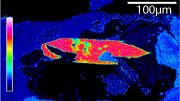
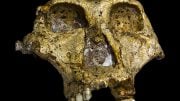


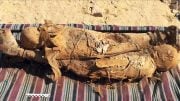



I learned I Pad Pro has LiDAR ! I can use this myself to see what’s below my feet or in an area that interests me. But you each article need to let people as questions. You probably won’t read this for quite a while but it’s nice to add my 2 cents . Thank you Every dig needs a few I Pad Pros the site that said this is working in Pompeii they mentioned a kitchen. If you allowed I’d send the article but not sure how & I have a photo of the I Pad Pro they are using !
iPad has LiDAR for AR applications and 3D scanning, and this can be quite useful in archeology (to scan artifacts, for example). However, it won’t help you see what’s under your feet. For that, you need ground penetrating radar (GPR), and some systems do send images and data over WiFi to iPad and other tablets. Albert Lin on NatGeo uses both LiDAR and GPR in his programs, and you can see the different uses of both technologies.